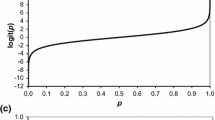Abstract
While z-scores provide participants with easy-to-interpret scores for quantitative proficiency tests, there is no universally accepted equivalent scoring method available for qualitative testing. Under the assumption that these tests follow a binomial distribution, it is possible to calculate scores that mimic the widely used z-scores and provide participants with insight into their performance level. We show that these scores, which we term a-scores, can be combined to provide a single score for multiple tests so that participants can monitor their performance over time, and discuss the use of the exact binomial test in place of uncertainty when there is no clear consensus.


Similar content being viewed by others
References
ISO/IEC 17043 (2010) Conformity assessment-general requirements for proficiency testing. International Organization for Standardisation (ISO), Geneva, Switzerland
Thompson M (2001) Proficiency testing: assessing z-scores in the longer term. AMC Tech Br., no. 24, www.rsc.org
Analytical Methods Committee (2001) Robust statistics: a method of coping with outliers, AMC Tech. Br., no. 6, www.rsc.org
Thompson M (2004) The amazing Horwitz function. AMC Tech. Br. no. 17, www.rsc.org
Thompson M, Ellison SLR, Wood R (2006) The International Harmonized Protocol for the proficiency testing of analytical chemistry laboratories (IUPAC Technical Report). Pure Appl Chem 78(1):145–196
Uhlig S, Bläul C, Frost K, Sgorzaly S, Colson B, Simon K (2015) Qualitative PT data analysis with easy-to-interpret scores. Accred Qual Assur 20(5):347–353
ISO/IEC 13528 (2015) Statistical methods for use in proficiency testing by interlaboratory comparison. International Organization for Standardisation (ISO), Geneva, Switzerland
McClure FD (1990) Design and analysis of qualitative collaborative studies: minimum collaborative program. J Assoc Off Anal Chem 73(6):953–960
Armbruster DA, Pry T (2008) Limit of blank, limit of detection and limit of quantitation. Clin Biochem Rev 29(Suppl 1):S49–52
Fera Science Ltd (Fera), Fapas® Proficiency testing. Available: www.fapas.com
Wehling P, LaBudde RA, Brunelle SL, Nelson MT (2012) Probability of detection (POD) as a statistical model for the validation of qualitative methods. J AOAC Int 94(1):335–347
Analytical Methods Committee (2015) Fitness for purpose: the key feature in analytical proficiency testing. Anal Methods 7(18):7404–7405
Analytical Methods Committee (2016) z-scores and other scores in chemical proficiency testing—their meanings, and some common misconceptions. Anal Methods 8(28):5553–5555
Medina-Pastor P, Mezcua M, Rodríguez-Torreblanca C, Fernández-Alba AR (2010) Laboratory assessment by combined z score values in proficiency tests: experience gained through the European Union proficiency tests for pesticide residues in fruits and vegetables. Anal Bioanal Chem 397(7):3061–3070
Bashkansky E, Turetsky V (2016) Proficiency testing: binary data analysis. Accred Qual Assur 21(4):265–270
Fera Science Ltd (Fera) (2017) Protocol for proficiency testing schemes. www.fapas.com
Author information
Authors and Affiliations
Corresponding author
Additional information
Publisher's Note
Springer Nature remains neutral with regard to jurisdictional claims in published maps and institutional affiliations.
Rights and permissions
About this article
Cite this article
Beavis, G., Wilson, J. & Sykes, M. Quantitative scores for binary qualitative proficiency testing. Accred Qual Assur 24, 263–269 (2019). https://doi.org/10.1007/s00769-019-01386-8
Received:
Accepted:
Published:
Issue Date:
DOI: https://doi.org/10.1007/s00769-019-01386-8




